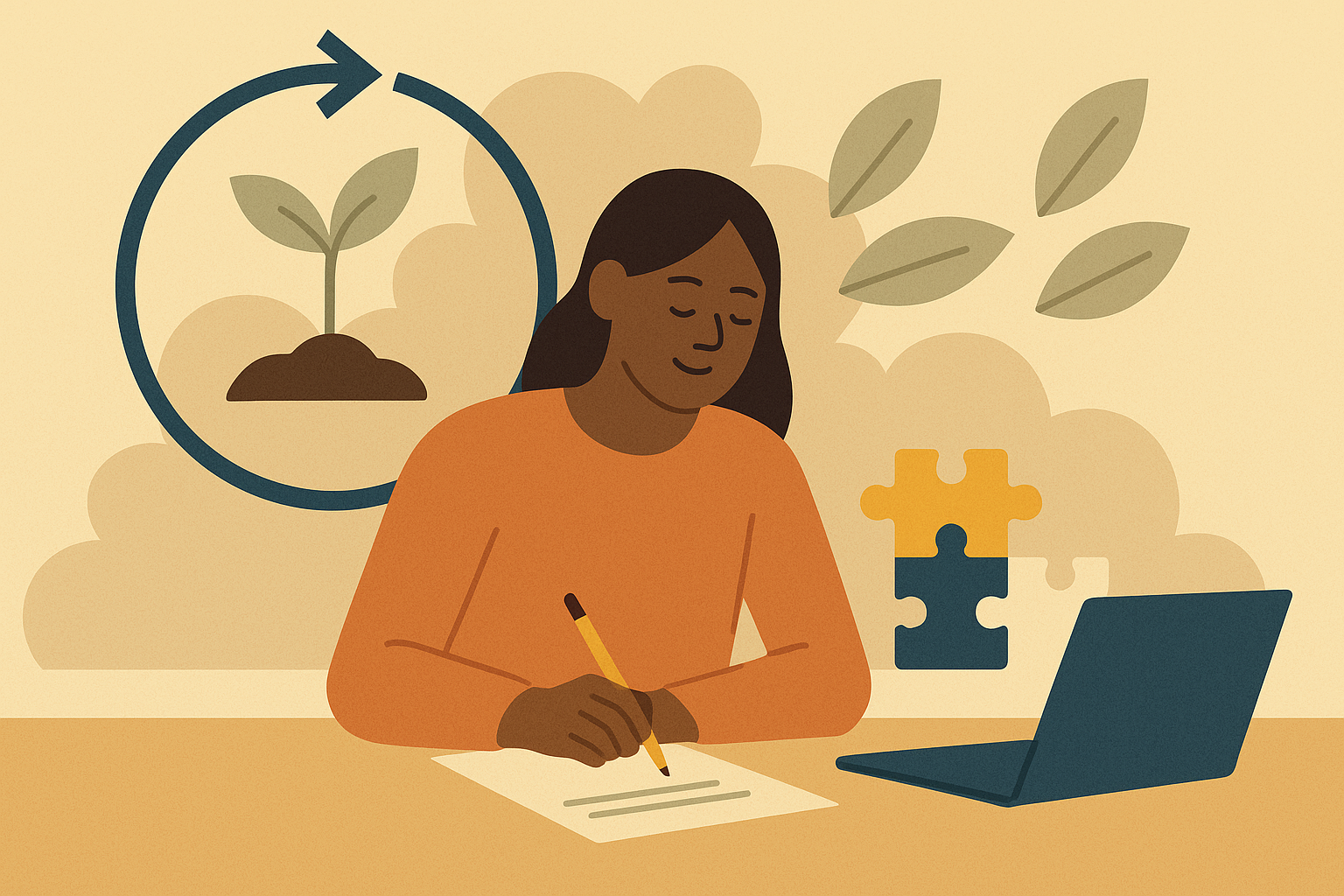ArticlesJune 13th, 2025
What Workshop Designers Can Learn From Circular Economy Principles


A strategic designer sketches ideas at her desk, surrounded by symbols of regeneration, systems thinking, and creative problem-solving—capturing the harmony between circular economy principles and thoughtful workshop design.
What workshop design can learn from circular economy principles
The circular economy protects finite resources by designing systems that preserve and replenish rather than extract from ecosystems. Taking inspiration from nature—where nothing is wasted and every output becomes an input elsewhere—this approach defines success through interconnected value creation rather than linear growth.
As a strategic designer with a background in circular economy product design, I see immense potential for other design disciplines to learn from circular thinking. Recently, while designing collaborative workshops for various organisations, I began noticing striking parallels between circular design strategies and effective workshop facilitation.
The finite resource of participation
Time is perhaps the most precious resource in workshop design. We hold responsibility for participants' time—a high-value investment—as well as the hours spent planning, designing, and synthesising outcomes. Just as circular designers carefully consider material inputs, workshop designers must thoughtfully steward the finite supply of people's time, energy, and goodwill.
This realisation led me to ask: what can workshop design learn from circular economy principles?
Four circular principles for workshop design
1. Build from what already exists
Circular products prioritise existing materials. Zero Co uses ocean plastic for its bottles. Uptex creates fabric entirely from textiles diverted from landfill. These companies recognise that the resources already in circulation hold immense value.
Similarly, before designing any workshop, ask: Is this workshop necessary? If yes, what information already exists that can inform our design?
In practice:
- Review previous consultations, surveys, and reports before planning activities
- Acknowledge and build upon past engagement efforts
- Ensure your questions address genuine knowledge gaps rather than retreading old ground
Nothing undermines trust faster than participants feeling you're ignoring previous work. As KA McKercher notes in their work on community participation, respecting what comes before is fundamental to ethical engagement.
2. Create regenerative by-products
When circular designers do create new inputs, they choose regenerative approaches. Companies like Ponda Bio, Kelp Blue, and Patagonia use farming methods that sequester carbon and create habitat while producing materials. Every input serves multiple purposes.
Workshops can operate similarly. Beyond your primary objective—whether gathering insights or reaching decisions—consider how each activity might serve additional purposes.
In practice:
- Design activities that are genuinely enjoyable, leaving participants energised
- Share facilitation techniques so participants can run similar processes
- Create space for relationship-building that extends beyond the workshop
- Document methods and templates for reuse by the community
Each activity should deliver value beyond its immediate purpose, creating ripple effects throughout the system.
3. Design for adaptability
Traditional products often fail because rigid construction prevents disassembly and reuse. Niaga redesigns mattresses and carpets with modular connections for easy end-of-life disassembly. Agency of Design's 'realist' toaster can be reconfigured to meet different user priorities.
Workshops demand similar flexibility. Despite careful planning, participants may need different conversations, activities might fall flat, or technology might fail. Modular design enables real-time adaptation.
In practice:
- Structure workshops as standalone modules that can be reordered or removed
- Clarify the purpose of each activity before the session
- Prepare alternative approaches for key activities
- Build in buffer time for unexpected deep dives
- Trust facilitator intuition to pivot when needed
This modular approach works with, rather than against, the inherent uncertainty of group dynamics.
4. Design with the end in mind
Circular products consider their entire lifecycle. BioPak designs compostable containers but recognises that composting requires user action. Their Compost Connect service ensures products reach appropriate facilities, closing the loop between intention and outcome.
Workshops need similar end-to-end thinking. Without clear pathways from activity to outcome to action, even brilliant sessions can feel hollow.
In practice:
- Design activities that naturally produce useable outputs
- Clarify before the workshop how information will be used
- Assign responsibility for synthesis and communication
- Set expectations with time-bound questions: "What change do you want to see in 6 months? One year? Three years?"
- Schedule follow-up communications during planning, not as an afterthought
- Share outcomes transparently with participants
Closing the loop isn't optional—it's essential for maintaining trust and demonstrating respect for participants' contributions.
From extraction to regeneration
Linear thinking has dominated professional practice for generations, but we're slowly shifting toward more systemic approaches. Circular economy principles offer tangible examples of how to move from extractive to regenerative practices.
When we treat time, energy, and goodwill as finite resources requiring careful stewardship, we design workshops that achieve immediate goals while strengthening the broader ecosystem of collaboration. Each workshop becomes an opportunity to build capacity, relationships, and trust that benefit future engagements.
Next time you plan a workshop, ask yourself: Am I designing a one-way extraction of knowledge, or am I creating a regenerative cycle that enriches all participants? How can this workshop contribute to healthier, more sustainable systems of collaboration?
The shift from linear to circular thinking isn't just about environmental sustainability—it's about recognising that in human systems, as in natural ones, nothing should be wasted and everything can contribute to regeneration.




